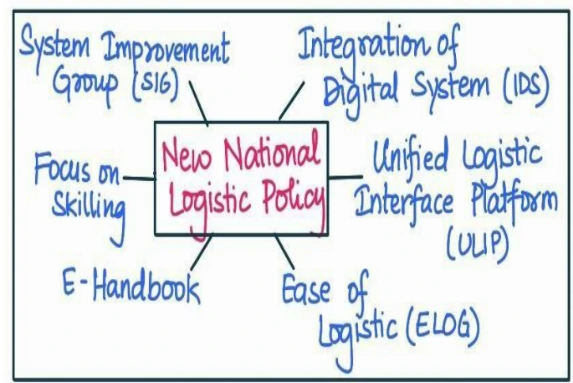Answer:
|
How to approach the question
- Introduction
- Write about India’s National Logistics Policy (NLP) briefly
- Body
- Write the potential impact of India’s National Logistics Policy (NLP) on integrated infrastructure development.
- Write potential future issues that could arise from its implementation.
- Suggest suitable way ahead in this regard.
- Conclusion
- Give appropriate conclusion in this regard
|
Introduction
India’s National Logistics Policy (NLP), 2022 aims to improve the logistics sector by enhancing productivity, optimizing costs, and ensuring efficient supply chains. It focuses on increasing competitiveness, creating jobs, and implementing a digitized logistics platform for easy access to various services.
Body
Potential impact of India’s National Logistics Policy (NLP) on integrated infrastructure development
- Promotion of Multimodal Infrastructure: The NLP encourages multimodal transportation, blending road, rail, air, and waterways. For example, the integration of inland waterways with rail and road networks could substantially reduce costs and congestion.
- Investment Attraction: A clear logistics policy could attract more private sector and FDI into infrastructure development. Eg: the Delhi- Mumbai Industrial Corridor, a mega infra- structure project planned as a high-tech industrial zone, which has garnered international interest.
Example- For Mumbai-Ahmedabad High-Speed Rail (MAHSR) project, JICA has offered loan of 300 billion yen (around Rs 18,750 crore)

- Improved Warehousing: It encourages the development of state-of-the-art warehousing facilities. The establishment of modern storage facilities can reduce wastage, especially in agriculture. Eg: modern cold storage facilities can reduce post-harvest losses and benefit farmers.
- Urban Infrastructure: It promotes integrated logistics infrastructure in urban areas, including Freight Terminals and Logistics Parks. It would decrease congestion in cities like Bengaluru and Mumbai, which have experienced traffic bottlenecks due to lack of planned logistics infrastructure. Example– India’s first Multi Modal Logistics Parks is being set up in Mappedu village in Thiruvallur district, near Chennai.
- Port Modernization: By promoting the modernization of ports and integrating them with other transport modes, the NLP can enhance India’s foreign trade. The Sagarmala Project is a case in point, aiming at port modernization and enhancing port connectivity.
- Technological Integration: The NLP advocates for the integration of technology like IoT, AI, and blockchain in logistics. This would improve tracking, reduce theft, and streamline the supply chain, as demonstrated by Maersk’s successful use of blockchain in their logistics operations.
- Development of Green Logistics Infrastructure: The policy encourages sustainable practices in logistics infrastructure, like the use of clean energy in warehouses and green freight transport, reducing the carbon footprint. concerns. Eg: the slow adoption of e-Way Bills due to technological challenges.
- Coordination among Different Modes of Transport: Ensuring seamless integration of different modes of transport could be challenging. Eg: achieving efficient multimodal transportation requires well-coordinated timetables, fares, and connectivity, which is difficult to manage.
- Cybersecurity Concerns: As the logistics sector becomes more digital, it could become a target for cyber attacks. For instance, Maersk faced a significant cyber attack in 2017, leading to disruptions in its operations.
- Skill Gap: Despite efforts in skill development, there could be a lack of skilled workforce proficient in managing advanced logistics operations. For instance, there might be a shortage of data analysts or AI specialists required to handle data-driven logistics operations.
- Resistance to Green Logistics: While the NLP encourages sustainable practices, their adoption could be slow due to higher initial costs and lack of incentives. For instance, solar-powered warehouses could face resistance due to the high upfront cost of solar panels.
- Macroeconomic Factors: Economic downturns, inflation, and currency fluctuations can impact the affordability and financial viability of infrastructure projects. These factors can affect project costs, financing options, and investor confidence.
Way ahead in this regard
- Unified Regulatory Framework: A unified regulatory framework that simplifies compliance across different states is crucial. The successful implementation of the GST can serve as an example of how unified regulations can simplify business operations.
- Robust Project Management: Ensuring timely completion of infrastructure projects requires robust project management strategies, clear timelines, and adequate resource allocation. Best practices from successful infrastructure projects like the Delhi Metro could be emulated.
- Attractive PPP Models: Government can develop more attractive PPP models, like Viability Gap Funding, to encourage private sector participation. The success of PPP in highway development projects like the Golden Quadrilateral can be a guiding example.
- Eco-friendly Logistics: Incentives and strict regulations are needed to encourage sustainable logistics practices. Renewable purchase obligations and subsidies for solar power installations are examples of such measures.
- Efficient Multimodal Integration: To facilitate efficient multimodal integration, a central coordinating agency could be set up, akin to the National Highways Authority of India (NHAI) for roadways.
- Skill Development Programs: Focus on skill development programs specifically tailored for advanced logistics operations is essential. Government-industry partnerships for setting up training centres, similar to the Skill India initiative, can be a successful approach.
- Enhance Cybersecurity: Strengthening cybersecurity measures in the logistics sector should be a priority. Regular audits, training programs, and robust cyber insurance policies can help mitigate risks.
Conclusion
The NLP has the potential to have a positive impact on integrated infrastructure development in India. Going ahead, it is important to monitor the implementation of the NLP closely and to address any challenges that arise in order to ensure that the policy is successful.
To get PDF version, Please click on "Print PDF" button.


https://uploads.disquscdn.com/images/259acdc64539e69c4a300f4ca4671d4053c3762938bca6cbd5968f899c228b5c.jpg https://uploads.disquscdn.com/images/e73430f2dd41c28fbd0bbef90b9e8d5ab10b01f0b54beb10a5f2198246add8e2.jpg